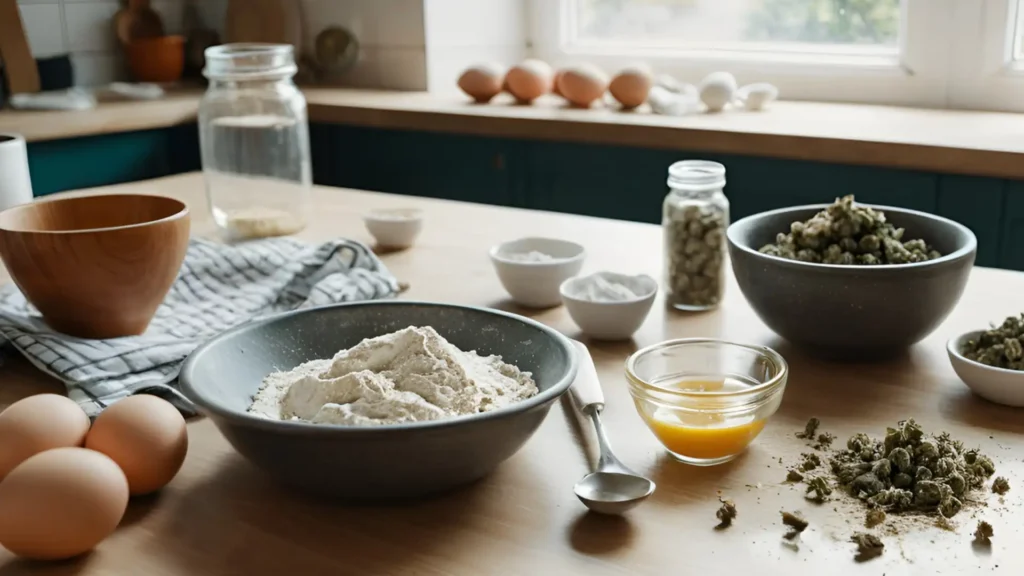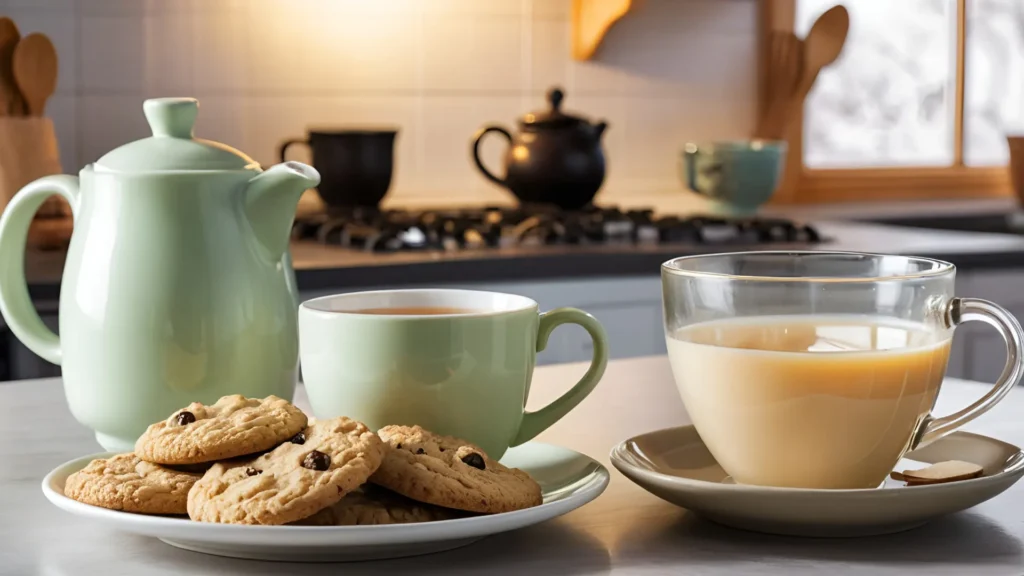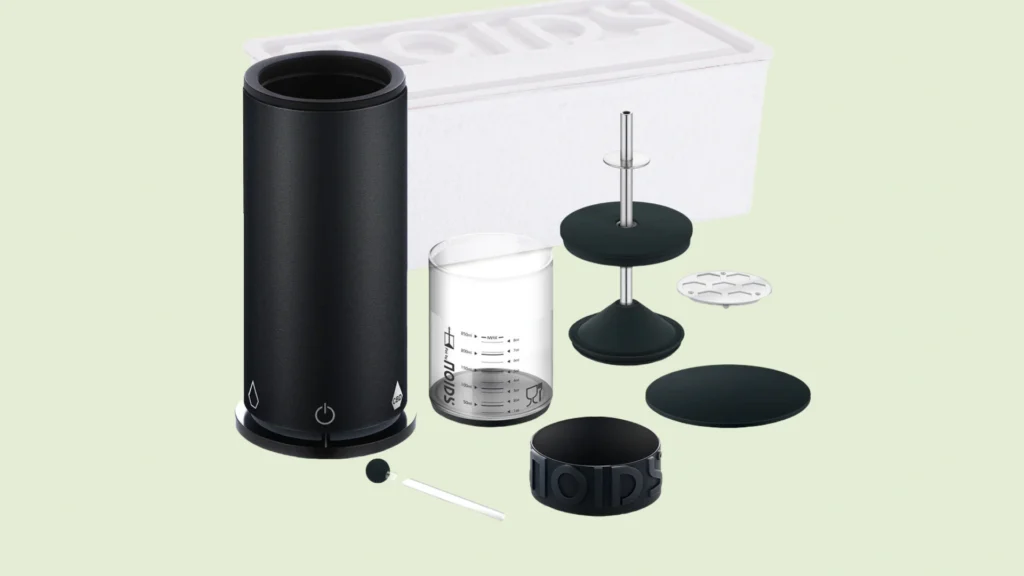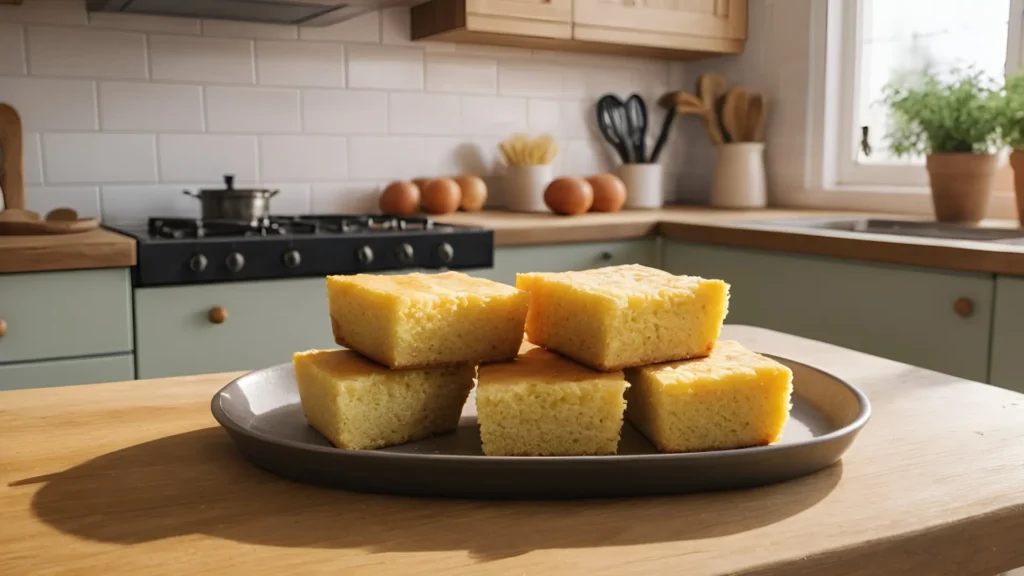I began cooking with cannabis by making a fruitcake and adding a random amount of cannabis-infused coconut butter. BIG mistake! I had no idea of the amount I had infused and no understanding of the potency. I learned my lesson and wasn’t harmed, but I began searching online for marijuana recipes for future use. So, here is my beginner’s guide to creating your very own cannabis recipes in the kitchen!
Table of Contents
*As an Amazon Associate, I earn from qualifying purchases
Why DIY Cannabis Edibles?
There’s something magical about transforming raw ingredients into delicious food. Plus, creating cannabis-infused treats at home means I can experience a whole range of benefits.
Experience the Benefits of Making Your Own Edibles
A homemade edible lets you feel more connected to what you eat. When you make your own, you know exactly what’s in them, and that makes a huge difference. Homemade edibles typically offer a longer-lasting high than smoking does, allowing you to enjoy your favourite strain for more time.
Enhance Your Cooking Skills with New Techniques
Experimenting with cannabis recipes in the kitchen can spice up your culinary skills. Honestly, once you dive into making infused cannabutter and cannaoil, you’ll find all sorts of fun ways to create cannabis recipes that are not only delicious but also really different! For me, it is also a tastier way to use weed. I’m used to the flavor of cannabis when vaping, but I don’t think I’ll ever really enjoy it like I do with cannabis cookies!
Control the Potency and Ingredients of Your Edibles
Imagine being able to decide how potent your edibles are. You can control the dosage, and that’s especially great if you’re aiming for specific effects or have dietary restrictions. Want a little more THC for a party or a mild CBD dose for relaxation? You can customise your experience perfectly.
Essential DIY Cannabis Recipes
The beauty of DIY marijuana cooking is that it allows you to control the ingredients and strength. Today, we’re diving into some essential cannabis recipes that will have you cooking up a storm!

Cannabutter: The Essential Ingredient
Cannabutter is a must-have for every cannabis cook. Think of it as the key to unlocking endless culinary possibilities. Why is it so incredible?
- Versatility: You can use it in almost any recipe that calls for butter, from brownies to sauces.
- Improved Absorption: The butter helps your body absorb THC and CBD cannabinoids more effectively.
- Long shelf life: If you make a large batch, it will keep in the fridge for a few weeks. Keep it longer by freezing it, and it will be good for several months.
CannaOil: A Versatile Alternative
If butter isn’t your thing, cannaoil has got your back! This oil can be used for healthy cooking, baking, or drizzling over dishes.
- All-Purpose Use: Perfect for salad dressings or sautéing veggies.
- High Smoke Point: Choose oils like heat-stable oils like Avocado or Coconut for the best results. Rice Bran oil has the highest heat stability of all oils and can be used in Skin, Haircare, and Cannabis Infusions.
- Long Shelf Life: This does mean that you need to use a heat-stable oil for the infusing process, and store it in a cupboard to slow down the oxidation. Many cake recipes use oil instead of butter.
Delicious Cannabis-Infused Cornbread
Who doesn’t love comfort food? Cannabis-infused cornbread is like a warm hug on a plate.
- Easily Customised: Add jalapeños or cheese for a gourmet touch.
- Perfect Pairing: Great with chilli or soup!
Savoury Cannabis Bacon
Yes, you heard that right! Cannabis bacon is surprisingly delightful.
- Savoury Goodness: The fat in bacon makes it the perfect carrier for cannabinoids.
- Easy to Make: Simply sprinkle decarbed cannabis on bacon and bake!
Relaxing Cannabis-Infused Tea
Need to unwind? Try cannabis-infused tea.
- Soothing Effects: Combine tea with cannabis for the ultimate relaxation.
- Easy Brewing: Just steep with a small amount of cannabutter.
These cannabis recipes are simple yet effective! Each dish offers unique flavours and experiences, whether you’re looking for something sweet, savoury, or relaxing. Are you ready to give them a try? Let’s get cooking!

CannaButter: The Foundation of Edibles
You can’t dive into the world of cannabis products without chatting about Cannabutter. It’s really amazing, like the superhero of cooking with cannabis! Why? Its versatility makes it an essential ingredient for numerous recipes and a gateway to a world of yummy cooking possibilities.
Why Cannabutter?
- Versatility: You’ll want to try cannabutter in so many cannabis recipes, it will fast become a staple in your kitchen. From brownies to tacos and popcorn, you can sneak it in wherever you want a little kick! Simply spread on toast with a little cinnamon is a great way to enjoy the start of your day if you are microdosing. It also improves the flavour and mouth feel of many dishes.
- Improved Absorption: The fat in butter helps your body soak up those cannabinoids like CBD and THC better. Ideally, you need to have some available fat to utilise the THC and CBD cannabinoids.
Step-by-Step Guide to Making Cannabutter
Let’s get into the nitty-gritty of making cannabutter!
- Decarboxylation: This is the magic step that activates the cannabinoids. Spread roughly 7 grams of cannabis evenly on a baking sheet. Grinding the herb isn’t required, but I usually do it to ensure it lays flat while infusing cannabis in oil or butter. Pop it in the oven at 120°C (250°F) for about 30 minutes. Keep an eye on it to avoid burning!
If you think you might be doing this a lot, read my POT by NOIDS review where you’ll see just how easy it is to decarb AND infuse with the one machine. You can even make tincture with it. Accurate temperature is crucial for optimal cannabinoid yield, as oven decarbing can result in a loss of up to 30% of valuable cannabinoids. - Melting and Maceration: Melt a block of butter over low heat. Gradually stir in the decarboxylated cannabis. Let it simmer for about three hours, stirring occasionally. If you have the POT by NOIDS, this will all be done in the same container.
- Straining and Storage: After the infusing has finished, strain the mixture through cheesecloth into a jar. The POT by NOIDS has the most efficient strainer I have ever used. Clean up is simple in the dishwasher. Let the infused butter cool and store it in the fridge. This will last about two weeks!

Tips for Determining Ratios and Potency
It’s crucial to find the right balance:
- Cannabis to Butter Ratios: A good starting point if you are new to weed baking is 7 grams of cannabis per 250 grams of butter. Many recipes use 14g per 250 gram of butter, but that level is usually for more experienced users. You can tweak this later based on how strong you want your weed effect to be.
- Potency Testing: I can’t afford a potency tester, so I make a note of the cannabis strain I have, and I look up the CBD and THC content online. Then I use the free PBN Potency Calculator to work out the strength of my cannabutter. This is a great way to gauge how strong your cannabutter is, helping you dose your recipes accurately.
Cannaoil: Another Versatile Infusion
Benefits of Using Cannaoil
Cannaoil is a fantastic way to elevate your cooking. Not only does it bring the benefits of cannabis into your meals, but it also adds a unique flavour profile. Think about it: instead of a plain oil, you’re adding something special. The versatility of cannaoil means you can use it for frying, sautéing, or even in salad dressings. Who wouldn’t want a delicious twist in their dish?
- Enhanced Flavour: Cannaoil adds rich, earthy notes to your dishes. Use a neutral oil like Rice Bran Oil or a nutty oil like refined Sesame oil.
- Health Benefits: Enhancing your dish’s nutritional value is easy by combining healthy vegetable oils with cannabis.
- Easy to Use: It’s a straightforward substitute in any cannabis recipe that requires oil.
- Use the Same Ratios as Cannabutter: That’s right – weigh the oil!
You might like to read my other blog about DIY Cannabis Oil.
A Straightforward Guide to Making Cannaoil at Home
Creating your cannaoil is simpler than you might think! Let’s break it down:
- Heating and Infusion: Start with your choice of oil (more on that later). In a saucepan, gently heat the oil with your decarboxylated cannabis over low-medium heat. Maintain this for about 2 – 4 hours. Yes, it takes time, but it’s mostly hands-off! Once again, the POT by NOIDS does this all by itself and gives the best results.
- Straining and Storage: Once finished, strain the mixture through a fine-mesh strainer or cheesecloth to remove the plant material (or the PBN strainer). Store your cannaoil in a cool, dark place, and it will last for several weeks.
Choosing the Right Oils for Infusion
This step is vital! You want to pick an oil that complements your cooking style. The infusion process involves heating the oil and not all oils are heat-stable for the length of time they need to be heated.
- High Smoke Point Oils: Oils like Coconut oil, Rice Bran oil or Avocado are ideal. They can handle high temperatures without breaking down. Olive oil is a good option for the POT by NOIDS because the machine maintains a safe temperature, preserving its flavour.
- Avoid Low Smoke Points: Stay away from oils like Rosehip, Chia Seed, and even Hemp Seed oil. They can burn easily and lose their nutritional value and flavour.
You can use cannabis-infused oil to make gummies. Try this Easy Vegan Cannabis Gummies recipe. If you prefer cookies, cannabis oil is another of the ingredients in this Space Cakes and Weed Brownies recipe.

Cannabis-Infused Cornbread: Southern Comfort Food
You know, there’s something truly special about the warmth of cornbread. It’s like a hug for your stomach! Now, imagine combining that comforting goodness with a little cannabis magic. Sounds amazing, right? Here’s my easy and delicious recipe for cannabis-infused cornbread that will have you wanting more!
Southern cooking has a way of bringing people together. And when you add cannabis to the mix, it becomes a unique dining experience. This cornbread is a perfect blend of tradition and modern twist.
Easy Cornbread Recipe Using Cannabutter
Let’s get down to the fun part – cooking! The foundation of our lovely cornbread is cannabutter. Here’s how to whip it up:
- Preheat your oven to 200°C (400°F).
- Mix together: In a mixing bowl, combine ⅓ cup of melted cannabutter, ⅔ cup of milk, and two eggs with a box of honey cornbread mix.
- Pour into a bread pan and bake for 30 minutes. Watch it rise and get a lovely golden brown colour!
Extra Touches for Deliciousness
Now, what’s better than just cornbread? Well, that’s easy. Spread some butter and top it with a sprinkle of sea salt for an extra special treat! Maybe add some rosemary and thyme into the mix before you bake it. Imagine a warm slice of cornbread with melted butter, a drizzle of honey, and a hint of cannabis – pure bliss!
Cannabis Bacon: Savoury and Simple
Yes, you read that right – cannabis bacon! This unique pairing brings together two of the most beloved ingredients: crispy bacon and the enchanting properties of cannabis. It’s not just delicious; it’s a fantastic way to incorporate cannabinoids into a savoury dish.
Why is bacon and cannabis such an exciting combination? Well, the fat in bacon acts as a wonderful carrier for cannabinoids, enhancing their absorption into your body. The weed adds an umami depth to the bacon. Just think about it: bacon brings those amazing flavours that can really take your breakfast or brunch to a whole new level!
Oven-Baking for Best Results
To preserve those precious terpenes and cannabinoids, I prefer cooking my bacon in the oven at a low temperature. If you fry it on a hot pan, you might destroy those delicate compounds. Who wants to waste all that goodness, right?
Step-By-Step Instructions for Making Cannabis Bacon
- Preheat your oven to 135°C (275°F).
- Line a baking sheet with strips of bacon.
- Sprinkle half of your decarboxylated cannabis over the bacon.
- Bake for 10 minutes, flip the bacon, then sprinkle with the remaining cannabis.
- Bake for another 10 minutes, or until the bacon is crispy and full of flavour.
And there you have it! A simple way to indulge in both bacon and cannabis. Enjoy the delightful combination, and perhaps pair it with eggs or your favourite breakfast dish. I promise, it’s worth the effort!
If you are travelling and staying in an hotel, you can also make 420 Firecrackers using the ironing board!
Cannabis-Infused Tea: A Relaxing Ritual
Have you ever thought about combining the soothing effects of tea with the calming benefits of cannabis? I know I have! It’s a delightful way to indulge and unwind. Trust me; it’s a relaxing ritual you won’t want to miss!
The Soothing Combination of Tea and Cannabis
When you think of relaxation, what comes to mind? I’m British, so for me, it’s curling up with a warm cup of tea. By adding cannabis, you get this dreamy experience that takes your relaxation to the next level. Imagine sipping on your favourite herbal blend while feeling the calming embrace of cannabinoids. It’s like a warm hug after a long day!
Making Cannabis-Infused Tea with Decarbed Cannabis
Now, let’s dive into the nitty-gritty of making this soothing brew!
- Step 1: Boil water and pour it into a mug with your chosen tea bag. I like to make it strong, so I use Yorkshire tea.
- Step 2: After a few minutes of letting it brew, take out the teabag and squeeze it. This releases a bit more of the tannins, which adds to the flavour.
- Step 3: Add a spoon of cannabutter or canna Coconut oil. This makes it easier for the cannabinoids to attach. I use a very strong cannabutter for this as I only want to add a half teaspoon. I like the buttery-ness it adds, but a big spoonful would not work for my taste buds.
Record Keeping and Safety
As we dive into the world of cannabis edibles, we must address an important aspect: keeping good notes and safety. It’s not just about cooking or baking; it’s about making sure we do so responsibly. So, let’s chat about a few key points to keep in mind!
Guidelines for Responsible Consumption
When it comes to munching on edibles, always start with low doses. Edibles can take anywhere from 30 minutes to 2 hours to kick in. Patience is essential! If you get a great result, you’ll be glad you kept notes so that you can make it again. If it was too strong for you or too weak, you’ll know how to adapt the recipe.
Also, be mindful of your surroundings. Consuming in a safe environment can lead to a more enjoyable experience. Having friends around can also enhance the fun, as long as everyone is on the same page about dosages!
Best Practices for Safely Storing Edibles
Now that you have your delicious cannabis creations, how do you keep them fresh and safe? First, always label your edibles. It’s crucial, especially if there are kids around. Store edibles in opaque containers in a cool, dark place to keep them discreet.
Here’s a tip: Consider using child-proof containers for added safety. Not only does this keep your treats safe, but it also helps avoid any mistaken munching. Remember, just because it looks like regular bacon doesn’t mean it is (try it in a BLT sandwich!)
Conclusion
Embarking on the journey of DIY cannabis cooking is both rewarding and educational. Making your own edibles allows you to control the potency, ingredients, and flavour, giving you a customised experience beyond just the effects of cannabis.
Enhancing classic dishes with cannabutter, experimenting with cannaoil, or adding a relaxing twist with canna tea is a uniquely satisfying experience. Just take your time and have fun with it! Enjoy the freedom to be creative, and don’t forget to jot down your cannabis recipes and experiences. It’ll definitely help make your next cooking session even more fabulous. Happy cooking!
🎧 Listen Instead
Prefer listening? Play it here or catch it on your favourite platform:
FAQ
How do I calculate the potency of my homemade edibles?
To estimate potency, determine the THC/CBD content of your cannabis, calculate the total milligrams in your batch, and divide by the number of servings. Online calculators can assist with this process.
Can I use any type of oil or butter for infusion?
Yes, but high-fat options like coconut oil or unsalted butter are preferred as they bind well with cannabinoids.
How should I store my cannabis-infused products?
Store them in airtight containers in the refrigerator for up to two weeks or freeze for longer shelf life. Always label them clearly and keep out of reach of children and pets.
Is decarboxylation necessary before infusion?
Yes, decarboxylating activates the THC/CBD in cannabis, making it effective in edibles. Skipping this step will result in less potent products.
How long do the effects of edibles take to kick in?
Edibles typically take 30 minutes to 2 hours to take effect, depending on various factors like metabolism and stomach contents. Start with a low dose and wait before consuming more.

If you liked this blog post, I would love it if you shared it with a friend.
If you use Pinterest, please pin this post.


 Spotify
Spotify


